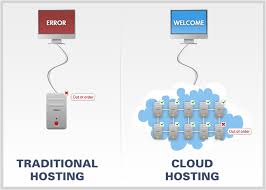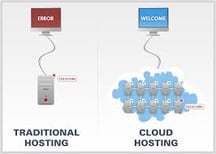
 Often users ask what's the difference between cloud hosted versus cloud based dental software. And the short answer is that they are pole apart - not the same products. The marketers are smartly using the buzz of cloud but in fact are recycling existing legacy dental practice management system in a new gift wrap. The article will help understand each type of product, key differences, and pros and cons.
Often users ask what's the difference between cloud hosted versus cloud based dental software. And the short answer is that they are pole apart - not the same products. The marketers are smartly using the buzz of cloud but in fact are recycling existing legacy dental practice management system in a new gift wrap. The article will help understand each type of product, key differences, and pros and cons.
Let's start with an explanation of cloud hosted and cloud based dental software.
As the name suggest, running the existing practice management software on a computer in a data center*, a group of computers managed together. In nutshell, instead of installing on a computer in the office, installing on one of the computers managed in a group. The users log into a remote computer over internet through remote desktop connection (RDC).
*Data Center (technical definition), a large group of networked computer servers typically used by organizations for the remote storage, processing, or distribution of large amounts of data.
Pros:
a) No need to manage in-house computer.
Cons:
a) Pay for the management service fees; will be higher than in-house cost. Also, marketeers will upsell services for hardware refresh, HIPAA compliance, 24/7 management, back-up and restore, etc.
b) The biggest downside, is the limitation of existing in-premises system are inherited. e.g: integration of systems like patient communication and engagement, payment is still a unsolved issue.
Further, such systems are marketed with a buzz of low monthly payment. Customers are explained that cloud computers managed in a group decreases the management cost and hence are cost effective. However, it is only partially true - managing a group of computers reduces the initial cost but unfortunately it doesn't scale cost effective. In economics language, the optimal curve reaches very quickly to a scale and thereafter the cost rises (it is beyond the scope of this article - economics of profit maximization).
In the end, the truth is that customer will end up paying much more compared to in-house system.
The cloud dental software are optimally designed to deliver the user functionality over the internet, a very subtle difference but far reaching efficiency and cost implications.
Let's consider an organization using Lotus Notes or Microsoft Exchange for their email services. It is designed to be installed and used within the organization's computer infrastructure. In contrast, a cloud based gmail services are optimally designed to be accessed via the Internet. Gmail is equally at home on any computer and in any browser and can easily service large group of users.
Pros:
a) Eliminates the management of Software and Hardware altogether.
b) The cost of services is low compared to hosed. The backups and restore; and software upgrade cost are very minimal.
c) Most services are designed to access from anywhere and any device over Internet. And, services can be delivered through wireless routers - no networked data cables.
d) Integration with other software will be done at application layer, which means that customer gets the integrated services transparently without getting involved.
Lastly, these systems are designed to scales effectively with low predictable cost and hence, large number of customers can be served at very low cost.
CONCLUSION:
In short, to evaluate a cloud solution, check for a) Is software running on cloud similar to in-house computer or is it a Gmail like cloud-based service; and b) cost of such a solution, .i.e. hosting, upgrades, backups and restore, integration with other systems, support, etc.
If the technical difference is not clear enough then take a cue from the cost of the system - higher the cost and additional charges/cost for services like backup, restore, integration, etc.
The software like tab32 is truly cloud-based designed to service the customer need over cloud with minimum Internet bandwidth, anywhere, any device and more importantly it is free of cost.
These Stories on Tips for Running a Dental Practice
No Comments Yet
Let us know what you think